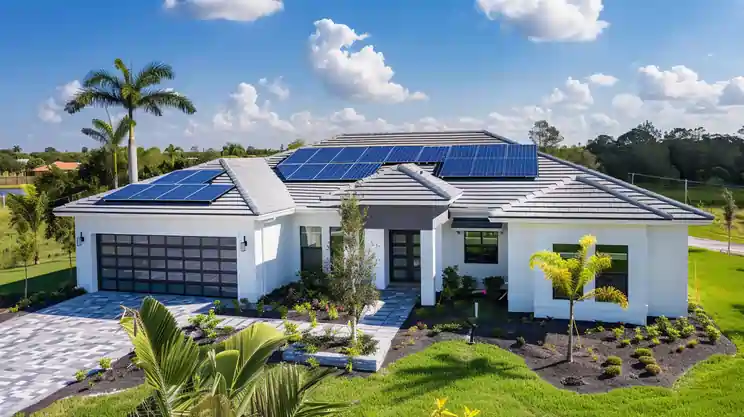As solar energy becomes increasingly popular, understanding how solar panels work can help you make informed decisions about adopting this renewable energy source. Here’s a comprehensive guide to how solar panels generate electricity, the components involved, and the benefits they offer.
The Basic Principle: The Photovoltaic Effect
The basic principle behind how solar panels generate electricity is the photovoltaic effect. When sunlight (photons) strikes the silicon cells in a solar panel, it knocks electrons loose from the silicon atoms. This generates a flow of electrical current that can be captured and converted into usable electricity.
Main Components of a Solar Panel System
A solar panel system consists of several key components that work together to generate, convert, and distribute electricity:
- Solar Panels: These contain photovoltaic cells made of silicon that convert sunlight into direct current (DC) electricity through the photovoltaic effect.
- Inverter: Converts the DC electricity from the solar panels into alternating current (AC) electricity that can be used in homes and fed into the electrical grid.
- Racking/Mounting System: The structure that holds the solar panels in place, oriented towards the sun for optimal energy production.
- Electrical Panel: Distributes the converted AC electricity from the inverter to power the home’s electrical circuits.
- Disconnect Switch: A safety switch that allows the solar system to be disconnected from the grid.
- Solar Battery (optional): Stores excess electricity generated for use when the solar panels are not producing power, like at night.
How the Photovoltaic Effect Works
The photovoltaic effect occurs when photons from sunlight strike the semiconductor material (typically silicon) in the solar cells, knocking electrons loose and allowing them to flow freely, generating an electrical current. This direct current (DC) electricity is then converted to alternating current (AC) by the inverter for use in homes and the grid.
Role of Inverters
Inverters play a crucial role by converting the direct current (DC) electricity generated by the solar panels into alternating current (AC) electricity that can be used by household appliances and fed into the electrical grid. Different types of inverters like string inverters, microinverters, and power optimizers are used based on the system design and requirements.
Connecting to the Electrical Grid
Solar panel systems are connected to the home’s electrical panel, which distributes the converted AC electricity from the inverter to power the home’s electrical circuits. If the solar panels generate more electricity than the home uses, the excess is sent to the utility grid, spinning the electrical meter backwards and providing credits on the homeowner’s utility bill.
Factors Affecting Solar Panel Efficiency
Several factors affect the efficiency of solar panels, including:
- Type of Solar Panel: Monocrystalline, polycrystalline, and thin-film panels have different efficiencies.
- Orientation and Tilt Angle: Panels should be oriented and tilted towards the sun for maximum exposure.
- Shading: Trees, buildings, or other obstructions can reduce efficiency.
- Temperature: Higher temperatures can reduce efficiency.
- Cleanliness: Dust, dirt, and snow can block sunlight and reduce output.
Installation Process
The installation process for solar panels typically involves:
- Site Evaluation and System Design: Conducted by a professional solar installer to assess suitability and design the system.
- Permits and Approvals: Obtaining necessary permits and approvals from local authorities.
- Installing the Racking/Mounting System: Setting up the structure that will hold the panels.
- Mounting and Wiring the Solar Panels: Installing the panels and connecting the wiring.
- Installing the Inverter(s) and Connecting to the Electrical Panel: Setting up the inverter and integrating it with the home’s electrical system.
- Inspection and Approval: Conducted by the local utility company to ensure safety and compliance.
- System Activation and Monitoring: Activating the system and setting up monitoring tools.
Maintenance Practices
Common maintenance practices for solar panels include:
- Regular Cleaning: Removing dirt, dust, and debris to maintain efficiency.
- Inspecting for Damage: Checking for any damage or loose connections.
- Trimming Trees or Removing Obstructions: Ensuring panels are not shaded.
- Monitoring System Performance: Using monitoring tools to track performance and address issues promptly.
Types of Solar Panels
There are three main types of solar panels:
- Monocrystalline: Made from a single silicon crystal, these are the most efficient but also more expensive.
- Polycrystalline: Made from multiple silicon crystals, these are less efficient but more affordable than monocrystalline panels.
- Thin-film: Made from thin layers of photovoltaic material like amorphous silicon or cadmium telluride, these are lightweight and flexible but less efficient than crystalline panels.
Real-World Examples
Solar panel systems are widely used in various applications:
- Rooftop Solar Installations: On homes and businesses.
- Ground-Mounted Solar Farms: Large-scale power plants.
- Building-Integrated Photovoltaics: Solar panels integrated into building facades and windows.
- Solar-Powered Water Pumps and Lighting Systems: In remote areas.
- Solar Panels on Vehicles: Cars, boats, and RVs equipped with solar panels for power.
Conclusion
Understanding how solar panels work can help you appreciate the technology behind this renewable energy source. By harnessing the power of the sun through the photovoltaic effect, solar panels provide a sustainable and efficient way to generate electricity. With proper installation and maintenance, solar panels can offer significant environmental, financial, and social benefits, making them an excellent investment for a brighter future.
